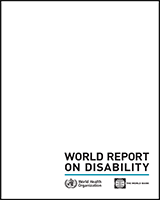All rights reserved. Publications of the World Health Organization are available on the WHO web site (www.who.int) or can be purchased from WHO Press, World Health Organization, 20 Avenue Appia, 1211 Geneva 27, Switzerland (tel.: +41 22 791 3264; fax: +41 22 791 4857; e-mail: tni.ohw@sredrokoob). Requests for permission to reproduce or translate WHO publications – whether for sale or for noncommercial distribution – should be addressed to WHO Press through the WHO web site (http://www.who.int/about/licensing/copyright_form/en/index.html).
NCBI Bookshelf. A service of the National Library of Medicine, National Institutes of Health.
The first ever World report on disability, produced jointly by WHO and the World Bank, suggests that more than a billion people in the world today experience disability.
People with disabilities have generally poorer health, lower education achievements, fewer economic opportunities and higher rates of poverty than people without disabilities. This is largely due to the lack of services available to them and the many obstacles they face in their everyday lives. The report provides the best available evidence about what works to overcome barriers to health care, rehabilitation, education, employment, and support services, and to create the environments which will enable people with disabilities to flourish. The report ends with a concrete set of recommended actions for governments and their partners.
This pioneering World report on disability will make a significant contribution to implementation of the Convention on the Rights of Persons with Disabilities. At the intersection of public health, human rights and development, the report is set to become a "must have" resource for policy-makers, service providers, professionals, and advocates for people with disabilities and their families.
Contents
- Foreword
- Preface
- Acknowledgements
- Contributors
- Introduction
- 1. Understanding disability
- 2. Disability – a global picture
- 3. General health care
- 4. Rehabilitation
- Understanding rehabilitation
- Addressing barriers to rehabilitation
- Reforming policies, laws, and delivery systems
- Developing funding mechanisms for rehabilitation
- Increasing human resources for rehabilitation
- Expanding and decentralizing service delivery
- Increasing the use and affordability of technology
- Expanding research and evidence-based practice
- Conclusion and recommendations
- References
- 5. Assistance and support
- 6. Enabling environments
- 7. Education
- 8. Work and employment
- 9. The way forward: recommendations
- Technical appendix A Estimates of disability prevalence (%) and of years of health lost due to disability (YLD), by country
- Technical appendix B Overview of global and regional initiatives on disability statistics
- Technical appendix C Design and implementation of the World Health Survey
- Technical appendix D Global Burden of Disease methodology
- Technical appendix E World Health Survey analysis for Chapter 3 – Health
- Glossary
The designations employed and the presentation of the material in this publication do not imply the expression of any opinion whatsoever on the part of the World Health Organization concerning the legal status of any country, territory, city or area or of its authorities, or concerning the delimitation of its frontiers or boundaries. Dotted lines on maps represent approximate border lines for which there may not yet be full agreement.
The mention of specific companies or of certain manufacturers' products does not imply that they are endorsed or recommended by the World Health Organization in preference to others of a similar nature that are not mentioned. Errors and omissions excepted, the names of proprietary products are distinguished by initial capital letters.
All reasonable precautions have been taken by the World Health Organization to verify the information contained in this publication. However, the published material is being distributed without warranty of any kind, either expressed or implied. The responsibility for the interpretation and use of the material lies with the reader. In no event shall the World Health Organization be liable for damages arising from its use.
- NLM CatalogRelated NLM Catalog Entries
- Services for people with communication disability in Fiji: barriers and drivers of change.[Rural Remote Health. 2015]Services for people with communication disability in Fiji: barriers and drivers of change.Hopf SC, McLeod S. Rural Remote Health. 2015 Jul-Sep; 15(3):2863. Epub 2015 Jul 21.
- The participatory development of international guidelines for CBR.[Lepr Rev. 2008]The participatory development of international guidelines for CBR.Khasnabis C, Motsch KH. Lepr Rev. 2008 Mar; 79(1):17-29.
- Health-related rehabilitation and human rights: analyzing states' obligations under the United Nations Convention on the Rights of Persons with Disabilities.[Arch Phys Med Rehabil. 2015]Health-related rehabilitation and human rights: analyzing states' obligations under the United Nations Convention on the Rights of Persons with Disabilities.Skempes D, Stucki G, Bickenbach J. Arch Phys Med Rehabil. 2015 Jan; 96(1):163-73. Epub 2014 Aug 15.
- Review WHO World Report on Disability: a review.[Disabil Health J. 2011]Review WHO World Report on Disability: a review.Krahn GL. Disabil Health J. 2011 Jul; 4(3):141-2.
- Review Service development for intellectual disability mental health: a human rights approach.[J Intellect Disabil Res. 2012]Review Service development for intellectual disability mental health: a human rights approach.Evans E, Howlett S, Kremser T, Simpson J, Kayess R, Trollor J. J Intellect Disabil Res. 2012 Nov; 56(11):1098-109.
- World Report on Disability 2011World Report on Disability 2011
Your browsing activity is empty.
Activity recording is turned off.
See more...
